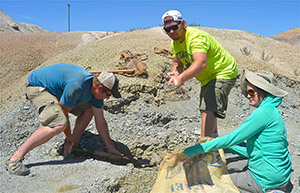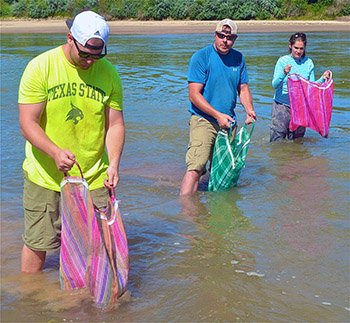LU geologists: the evidence is in the details
 Sometimes the big picture can only be seen in the details. Such is the case when trying to determine the true picture of what populated the Earth millions of years ago. While the larger creatures capture the public’s imagination, knowing what was underfoot helps give a fuller picture of a particular place and time.
Sometimes the big picture can only be seen in the details. Such is the case when trying to determine the true picture of what populated the Earth millions of years ago. While the larger creatures capture the public’s imagination, knowing what was underfoot helps give a fuller picture of a particular place and time.
Through the years, Jim Westgate, University Professor Earth and Space Sciences at Lamar University, has not only excavated the largest of creatures – ancient whales, giant sharks, towering dinosaurs, and mega-scale mammals – he has also spent considerable time and effort sifting out evidence of the smallest creatures as well.
This past July and August, Westgate and LU senior geology majors Melisa Guillot and Chris Sanders, both of Port Neches, joined by Westgate’s son Jeff Westgate, a senior at Texas State University in San Marcos, continued paleontological studies of the community which inhabited the Uinta Basin in northeastern Utah, 42 million-years ago. Their goal was to excavate more than four tons of bulk sample from a fossil site known as WU-26 or "The Pond,” one 50 lb. burlap bag at a time.
 After the shovel work, they concentrated the sample so it could be transported to the LU Paleontology Lab for further processing. Using fine mesh screens and washing in the nearby Green River, the team reduced each ton of sample to about 100 lbs. of sand grain-size sediments containing tiny mammal teeth and bones of other animals.
After the shovel work, they concentrated the sample so it could be transported to the LU Paleontology Lab for further processing. Using fine mesh screens and washing in the nearby Green River, the team reduced each ton of sample to about 100 lbs. of sand grain-size sediments containing tiny mammal teeth and bones of other animals.
Back at the LU Paleontology Lab, the students soaked their concentrated samples in naphtha overnight and then screen-washed them with water, which reduced the original 8,500 lbs. of mudstone to less than 30 lbs. of final concentrate of fossil bone fragments, teeth, and quartz sand grains, Westgate said.
The final concentrate is now being sorted in the lab with screens of successively finer mesh, he said.
“The next step will be to identify the fossils,” Westgate said. Anything larger than 2 mm can be seen by eye; however, anything smaller is sand grain-size and must be searched for using binocular microscopes.
Westgate and his LU students have been excavating and processing fossils from "The Pond" site since 2007. Based on previous sampling, Westgate expects to recover about 200 complete molar teeth from tiny primates, rodents, shrews, opossums, rabbit-sized 4-toed horses, rabbit-sized deer-like mammals, and actual rabbits that immigrated into North America for the first time about 42-million years ago. This year's large sample brings the nine-year sample total to more than 26 tons with more than 500 tiny mammal teeth captured so far, Westgate said. Each tooth is mounted on a pin stuck in a cork for easy handling and photographing and then placed in its own sample vial.
 Non-mammal fossils aid in the interpretation of the tropical or subtropical climate of the Central Rocky Mountains 42-million years ago, just prior to the extinction of primates native to the region at that time, Westgate said. The most common of these are remains of fish like bowfin and gar, along with aquatic turtles. Crocodile and alligator bones and teeth are also common and provide evidence that fossils at the site were deposited in a pond or oxbow lake near a stream.
Non-mammal fossils aid in the interpretation of the tropical or subtropical climate of the Central Rocky Mountains 42-million years ago, just prior to the extinction of primates native to the region at that time, Westgate said. The most common of these are remains of fish like bowfin and gar, along with aquatic turtles. Crocodile and alligator bones and teeth are also common and provide evidence that fossils at the site were deposited in a pond or oxbow lake near a stream.
This summer, the team also collected samples to be analyzed for pollen and fern spores by Carole Gee, a paleobotanist from the University of Bonn, Germany, who has collaborated with Westgate in the past.
 Although fossils were first discovered in the geologic unit known as the Uinta Formation in 1870, "The Pond" site is the first micro-mammal locality in the upper, or younger, part of the Uinta Formation. Teams from Lamar University have recovered several mammal species previously thought to have gone extinct millions of years earlier, Westgate said. The most significant of these is a diverse suite of four or five tarsier-like primate species, which runs counter to recent scientific literature stating that only one species of primate survived extinction events in the Uinta Basin prior to 42-million years ago.
Although fossils were first discovered in the geologic unit known as the Uinta Formation in 1870, "The Pond" site is the first micro-mammal locality in the upper, or younger, part of the Uinta Formation. Teams from Lamar University have recovered several mammal species previously thought to have gone extinct millions of years earlier, Westgate said. The most significant of these is a diverse suite of four or five tarsier-like primate species, which runs counter to recent scientific literature stating that only one species of primate survived extinction events in the Uinta Basin prior to 42-million years ago.
A LU Research Enhancement Grant awarded to Westgate helped fund the 2015 field season and the effort to collect potential pollen samples from "The Pond." Another grant to Westgate from the Petroleum Research Fund (American Chemical Society) is now in its fourth and final year. In addition to helping to cover field expenses and student salaries, it has covered salaries for students to carry out lab activities and pay for analysis of the pollen samples.


